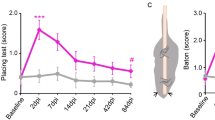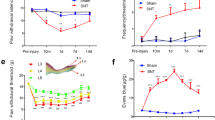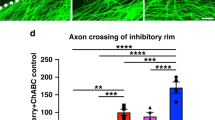Abstract
IT has generally been assumed that the connections of spinal cord cells are laid down during development and then remain stable throughout adult life. However, it has been shown that dorsal horn cells can be excited in a novel fashion by afferents over distant intact dorsal roots if section of nearby dorsal roots results in the degeneration of the afferent sensory fibres which normally activate the cells1. Here we show that this plasticity of afferent connection can be provoked by section of peripheral nerves where there is no gross anatomical change of the central terminals of the sectioned fibres and yet the cells on which the cut nerves end begin to respond to the nearest intact nerves.
This is a preview of subscription content, access via your institution
Access options
Subscribe to this journal
Receive 51 print issues and online access
$199.00 per year
only $3.90 per issue
Buy this article
- Purchase on Springer Link
- Instant access to full article PDF
Prices may be subject to local taxes which are calculated during checkout
Similar content being viewed by others
References
Basbaum, A. I. & Wall, P. D. Brain Res. 116, 181–204 (1976).
Brown, P. B. & Fuchs, J. L. J. Neurophysiol. 38, 1–9 (1975).
Wall, P. D. J. Physiol., Lond. 188, 403–423 (1967).
Wall, P. D. & Werman, R. J. Physiol., Lond. 255, 321–334 (1976).
Devor, M. & Wall, P. D. Brain Res. 118, 325–328 (1976).
Devor, M., Merrill, E. G. & Wall, P. D. J. Physiol., Lond. 270, 519–531 (1977).
Wall, P. D. & Gutnick, M. Expl. Neurol. 43, 580–593 (1974).
Konorski, J. & Lubinska, L. Lancet 250, 609–611 (1946).
Colmant, H. J. Arch. Psychiat. NervKrankh. 199, 60–83 (1959).
Barron, K. D. & Tuncbay, T. O. Arch. Neurol. 7, 203–215 (1962).
Schoenen, J., Budo, C. & Poncelet, G. C.r. Séanc. Soc. Biol. 162, 2035–2045 (1968).
Rustioni, A., Baan, J. W. & Verdonk-Karlsen, S. Brain Res. 37, 137–145 (1972).
Knyihar, E. & Csillik, B. Expl. Brain Res. 26, 73–87 (1976).
Grant, G. & Arvidsson, J. Brain Res. 95, 265–278 (1975).
Westrum, L. E., Canfield, R. C. & Black, R. G. Brain Res. 101, 137–149 (1976).
Gobel, S. & Binck, J. M. Brain Res. 132, 347–356 (1977).
Govrin-Lippmann, R. & Devor, M. Brain Res. (submitted).
Lieberman, A. R. Int. Rev. Neurobiol. 14, 14 (1971).
Mendell, L. M., Munson, J. B. & Scott, J. G. Brain Res. 73, 338–348 (1974).
Wall, P. D. Phil. Trans. R. Soc. B. 278, 361–381 (1977).
Merrill, E. G. & Wall, P. D. J. Physiol., Lond. 226, 825–846 (1972).
Author information
Authors and Affiliations
Rights and permissions
About this article
Cite this article
DEVOR, M., WALL, P. Reorganisation of spinal cord sensory map after peripheral nerve injury. Nature 276, 75–76 (1978). https://doi.org/10.1038/276075a0
Received:
Accepted:
Issue Date:
DOI: https://doi.org/10.1038/276075a0
This article is cited by
-
Experience-dependent plasticity in early stations of sensory processing in mature brains: effects of environmental enrichment on dendrite measures in trigeminal nuclei
Brain Structure and Function (2022)
-
Differential Changes in Neuronal Excitability in the Spinal Dorsal Horn After Spinal Nerve Ligation in Rats
Neurochemical Research (2016)
-
Activated Microglia Contribute to Convergent Nociceptive Inputs to Spinal Dorsal Horn Neurons and the Development of Neuropathic Pain
Neurochemical Research (2015)
-
Convergent Nociceptive Input to Spinal Dorsal Horn Neurons After Peripheral Nerve Injury
Neurochemical Research (2015)
-
Peripheral nerve injury activates convergent nociceptive input to dorsal horn neurons from neighboring intact nerve
Experimental Brain Research (2015)
Comments
By submitting a comment you agree to abide by our Terms and Community Guidelines. If you find something abusive or that does not comply with our terms or guidelines please flag it as inappropriate.



